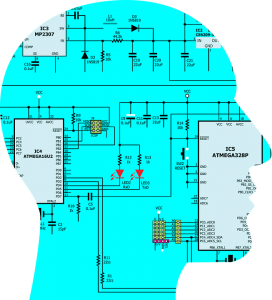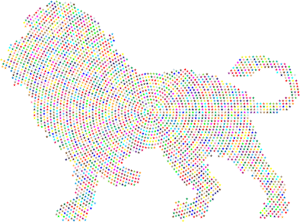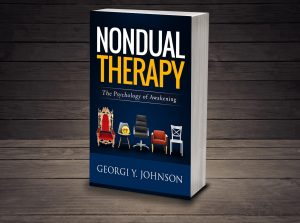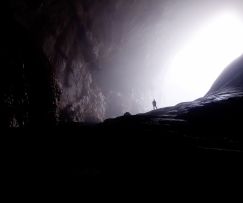[Extracted from the new book by Georgi Y. Johnson – Nondual Therapy: The Psychology of Awakening.]
Historically, we believed that the brain stops growing after childhood. In this decade, science has established that this is untrue. The brain is constantly healing, evolving and opening for transformation. Significant changes in brain mass, connectivity and performance can be encouraged for as long as we live.
The brain is a magnificent receiver and data processor between dimensions of consciousness, including the physical dimension of which the brain is a part. Although we inherit our brains and their conditioned reflexes, these neural pathways are not absolute. The structure of our brain is not fixed. It’s formed and influenced most directly by a timeless and infinite source of consciousness, and in this, it can rewire, reroute and evolve through time and space. The brain has a tremendous power to heal its disconnections and to release old software that no longer serves the well-being of the whole. Neurologists refer to this process of rewiring as neuroplasticity, a phenomenon that is deeply supported by Nondual Therapy.
 Neurologist Prof. James H. Austin took a train on the London Underground to keep an appointment. Anyone who knows the Underground can imagine that to the uninitiated, it can be a confusing web, with a multi-colored map of circular routes and dead ends that could evoke the image of a neural network. By mistake, Austin took the train in the wrong direction. He tried to reverse the mistake, and found himself lost with no hope of making the appointment on time. Despondently, he ascended one of the long escalators to the surface to try and figure out where he was. Disorientated, he looked around, and perhaps trying to anchor himself, looked up to the blue sky. In that moment, his spirit expanded, and he felt a surge of unbounded, cause-less consciousness. He was lost, disorientated and late according to his personal agenda, but in that moment, he experienced pure, existential freedom.
Neurologist Prof. James H. Austin took a train on the London Underground to keep an appointment. Anyone who knows the Underground can imagine that to the uninitiated, it can be a confusing web, with a multi-colored map of circular routes and dead ends that could evoke the image of a neural network. By mistake, Austin took the train in the wrong direction. He tried to reverse the mistake, and found himself lost with no hope of making the appointment on time. Despondently, he ascended one of the long escalators to the surface to try and figure out where he was. Disorientated, he looked around, and perhaps trying to anchor himself, looked up to the blue sky. In that moment, his spirit expanded, and he felt a surge of unbounded, cause-less consciousness. He was lost, disorientated and late according to his personal agenda, but in that moment, he experienced pure, existential freedom.
The brain scientist underwent a spontaneous awakening out of the limited pathways of the conditioned mind. He had metaphorically and literally transcended the limits of the map. The scientist went on to pioneer the bridge between brain science and spirituality, authoring the book Zen and the Brain. In the book he describes that life-changing shift of brain function from thought to experience:
“Atomic physicists can tell us in words that we are all derived from stardust. But Zen takes our interpenetration with the universe literally. Its insight strikes as a fact of experience. This deepest truth is not captured in words. Insight information, like a cool drink of water, has an impact at levels beyond reasoning.”
At Harvard University’s Lazar Lab, a plethora of research is underway exploring the powerful links between practices of mindfulness and yoga, and conditions such as anxiety and depression. Led by Prof. Sarah Lazar, the team was one of the first to publish a paper showing the significant physical changes in the brain that occur with meditation. Through Magnetic Resonance Imaging (MRI), the research reveals that experienced meditators have a thicker cortex than non-meditators, especially in areas associated with attention, interoception and sensory processing. Interoception is the term given for our awareness of inner states – that translates into signals through a diversity of neural pathways. When these signals break down, it has been associated with mental disorders such as anxiety, depression, panic disorder, anorexia nervosa, bulimia nervosa, posttraumatic stress disorder (PTSD), obsessive compulsive disorder (OCD), autism spectrum disorders and others. Thus, a direct link was made between meditation and overall health. Support of the brain’s ability to receive information about emotional contraction is fundamental to the physical, psychological and mental wellbeing of the whole.
 Loosely used, neuroplasticity refers to this miraculous ability of the brain to reform itself. On the level of neural networks, this is about connectivity, association and identification. From the Nondual perspective, it’s about the power to transform our minds out of a predetermined, dualistic system, to access greater, non-discriminating aspects of human potential. It’s about the opening of the higher mind that can oversee all duality.
Loosely used, neuroplasticity refers to this miraculous ability of the brain to reform itself. On the level of neural networks, this is about connectivity, association and identification. From the Nondual perspective, it’s about the power to transform our minds out of a predetermined, dualistic system, to access greater, non-discriminating aspects of human potential. It’s about the opening of the higher mind that can oversee all duality.
The key ingredient? The disinvestment of our conscious awareness from the belief that thought forms are absolute, that they are fixed, unchangeable and that they decree who or what we are. Out of this third position above binary mind, an unbounded sense of self emerges which is prior to judgement: it’s neither susceptible to judgement from the outside, nor is it judgmental. The cultivation of the ability to rest in the powerful, Nondual Quality of choice (Part II, Chapter 1), irrespective of decisions and actions taken – and even while the activity of judgement and choosing occurs – brings a flexibility and responsivity to the here and now that supports neuroplasticity.
To change our minds, we need to allow the insecurity of change. This is an allowance of the impermanence of body, heart and mind that can evoke fear around all that we seek to control. Often, what we want to control is our own worst nightmares. We try to create stability to block the potential shock of something horrible, but in doing this, we try to imagine the horrible to keep it at bay. This involves fixating the world – and the brain’s perception of it – to grasp the desirable and to push away the undesirable. But this fixation dulls the brain’s ability to perceive. We refuse change within the whole, to prevent our worst fears from springing on us. This refusal of change is a rejection of vitality in the brain and this rejection ultimately enslaves us in stagnating thought patterns.
In neuroscience, the maxim is that: neurons that fire together, wire together. This means that if it’s been learned that spiders are a death threat, then neurons associating spiders with extreme fear will instantaneously spark together, even on perceiving a grey ball of wool. The more this happens, the more concrete the association becomes, and the more ‘real’ the fear appears to be. The more frequently we all react the same way, the more this illusion is shared and appears to be universal. All balls of wool are scary.
 Neuroplasticity means we can change the structure of neural networks, possibilities of experience and our subjective reality. It always involves a rising out of the binary form of ‘either-or’ into the perception of the ‘and-and’ through the emergence of a third position in the mind that can allow both sides of a duality.
Neuroplasticity means we can change the structure of neural networks, possibilities of experience and our subjective reality. It always involves a rising out of the binary form of ‘either-or’ into the perception of the ‘and-and’ through the emergence of a third position in the mind that can allow both sides of a duality.
For example, although the arachnophobia has become the road most travelled, it’s no longer perceived as the only road possible. New networks can form with the repeated creation of new associations by adding new aspects to the experience. The habitual reaction will stay for a while, but other possibilities are added which disinvests belief and dramatically decreases the biochemical survival responses in the brain. Thought patterns begin to reform, encouraged by a relaxation of the nervous system and effects that reward and support body, mood and mind.
Many thoughts are subconscious – they are active as energetic vibrations before they emerge as language or image. This is because we have been collectively programmed by impulses of fear and survival. Because this programming is fear based, our first reflex is to restrict our consciousness or to close the mind – even to our own reflexive fear responses. This is based on an immature experiential belief around perception – that if you don’t look at it, it’s not there. It’s rather like the instinct of covering our eyes to make the monster go away, or covering our eyes to make ourselves disappear.
Because such conditioned networks of repeated suffering are less conscious, they are also less available for transformation. We can’t heal something if we are not aware that it’s there. What the mind is unable to process will be taken up by the body, reflected in contractions around breathing and movement and processing through physical pain and disease.
In all this, there is an aspect of attending awareness from above or beyond mind-body activity which is critical to change and transformation. This awareness offers a continuous third dimension to the binary nature of thought and experience. Without awareness of the patterns and tendencies of our minds, we encounter difficulty taking new routes.
Imagine that for generations, your family has walked a route to the sea. It’s imprinted in your genes. It was walked by both your parents and grandparents. The whole community walks this route. Your feet seem to take that direction by themselves. One day, you get a chance to hang glide above the terrain. You see the well-trodden route to the ocean. It curls, climbs a steep slope, bends backward to avoid some life-threatening thistles, and then twists back to descend a perilous cliff edge. Even though the ground is smooth, and the way is clear, it goes through a reserve of poisonous snakes. Indeed, some of your ancestors were bitten and never made it – which is given as a reason for the ambulation up to the cliff edge. The very danger is taken as proof of the need to stick to the same route.
From above, you see another way that leads directly to the sea without complications. It’s overgrown with brambles, but it’s by far the fastest, safest and easiest. All you need is to walk it and cut out the foliage. Each time you do this, it will get easier. Nobody needs to die. In fact, on this direct route, you get the view of the ocean every step of the way. Your family might think you’re crazy and a traitor. They’ll warn you about the dangers of the unknown. They’ll remind you of the trauma with the poisonous snake. But who would not forge the new path, having seen the terrain from above? Who would not share this easier way with others? The old path is still there, to be used if needed, but other options have emerged. What is needed to access other pathways, unrestricted by the biochemical patterning of memory? Relaxation and the disinvestment from known pathways as absolute through a willingness to release addiction and step into the potential confusion of the unknown.
Neuroplasticity involves releasing the exclusive rights of one pathway, and allowing others to form according to new insight. Between one road and the next, support comes from a transcendental position that is not obligated to any path. At first, this unconditional point of view is provided through the attending awareness of the therapist. When we have the support of an awareness unrestrained by fear and the threat of outcomes, predetermined reactions become relativized: they lose their tyrannical hold on reality.
When a therapist is not present, techniques such as mindful breathing, visualizing a triangle, repeating a mantra or blessing, or simply opening the awareness of the physical contact with the feet on the ground can provide a supportive third point out of which to release predetermined patterns. This resting in a third space beyond the terrain of the individual mind unhooks the predetermined, conditioned pathway by adding first one, and then a range of possibilities to the inner landscape. Therefore, behavioral therapy can sometimes be effective. Through discipline and repetition, new behaviors are introduced that disempower the grip of established thought forms. It works from the outside-in, whereas in Nondual Therapy we work outside-in and inside-out at the same time.
Teachings such as the Power of the Now by Eckhart Tolle, provide, for example, a position to encourage neuroplasticity by resourcing the present moment – the ‘here’ and ‘now’. In this book, we describe a range of Nondual Qualities that serve as resources in forming a feeling connection with a freely available aspect of being that is outside the lock of duality. Through the wider freedom of a transcendental point of reference, new possibilities emerge, also at the somatic or unconscious levels.
According to holistic health advocate Dr, Andrew Weil:
“Neuroplasticity means that emotions such as happiness and compassion can be cultivated in much the same way that a person can learn through repetition to play golf and basketball or master a musical instrument, and that such practice changes the activity and physical aspects of specific brain areas.”
Neuroplasticity takes place in the healing of memories. Here there is some confusion and the idea can provoke annoyance and defensiveness, as there is a clinging to the established story – “What happened, happened! It can NEVER be undone.” While this is true, (we cannot undo what has been done), most painful memories are locked in a certain perspective. They involve the re-experiencing of a limited collection of neural networks. Memory tends to reflect a mental contraction where the suffering aspect monopolizes the scene, and the rest is denied.
 This is especially true of traumatic memories, where there is a polarization between the content of memory and normal, everyday life. When we let memory come alive in the Now, fresh details reveal themselves in a many shades and colors. The pain can be worse at first. How much more painful is the memory of the bleeding soldier on the battlefield when we acknowledge the backdrop of a brilliant sunset, with a melody of singing birds? Yet this is how memory begins to de-contract as the past comes to life in the Nondual Quality of the Now.
This is especially true of traumatic memories, where there is a polarization between the content of memory and normal, everyday life. When we let memory come alive in the Now, fresh details reveal themselves in a many shades and colors. The pain can be worse at first. How much more painful is the memory of the bleeding soldier on the battlefield when we acknowledge the backdrop of a brilliant sunset, with a melody of singing birds? Yet this is how memory begins to de-contract as the past comes to life in the Nondual Quality of the Now.
Experiential memory is alive in the here and now. Within these living qualities, memory can expand and focus. It expands to offer that same overview of the terrain, but includes the experience of other people or the emotional atmosphere surrounding the event. Deeper layers of experience can be uncovered. For example, the pain beneath the rage: beneath that pain there could be loss, beneath the loss there could be the timeless fulfillment in what has been. When we release our grasp, memory can unfold into life, to allow more of what was there (and what is still here) into consciousness.
Without changing any of the established events of the ‘happening’, memory increases its plasticity, with new neural networks forming that reveal new perspective, identification, association and possibility. Just one forgotten detail of a traumatic memory can be enough to break open a fixed network. Think of a traumatic event in your life. Ask yourself a random question that you never thought of before, such as: what shoes am I wearing? What am I feeling in my hands? What smells are here? What happens next (after the story is done)?
By domino effect, neurons that associate problems as being fixed, predetermined and unchangeable also become relative. The very movement of transformation means the neuron that shouts “doomed!” in perpetual self-condemnation runs out of bullets. With this, the experience of transformation itself becomes associated not with danger, but with well-being, freedom and strength. Change is allowed, and change can heal the connective freedom of the brain that has been denied. Understanding begins which leads to insight; and this insight into the nature of experience leads to peace.
Whereas neural pathways were previously followed with the agenda of escaping old pain, new networks form under the incentive of freedom. This is supported by the whole body-mind that inherently yearns toward insight, peace and wellbeing.
Most language and verbal thought is coded a priori with duality. Thought has its own resonance of fear and threat. In this, the mind, with its binary programs, tends to support the experience of reality as fragmented. It enhances and dictates the division between the ‘I’ and the whole, and above all denies the evolution out of its own programs into new dimensions of mind.
 It should be noted that the ‘and-and’ of the Nondual mind does not exclude the either-or of duality, but rather, radically includes it. With this higher layer of mind, consciousness is not caught within the thought or concept, but rather has an almost playful overview. It’s as if consciousness were a sun perceiving the whole terrain of thought beneath: it can see both left and right, surface and depth, without getting caught in contraction. Out of higher mind, we can witness thoughts seeding and connecting in silence before they even reach expression. From higher mind, we can truly listen to the miracle of thought – this voice inside the head – and marvel at its capacity. From higher mind, we can also rest in the deeper wisdom of the transience and emptiness of thought. A Nondual position does not cancel out duality, rather, it radically allows both sides of a duality to come to life and to dance in freedom.
It should be noted that the ‘and-and’ of the Nondual mind does not exclude the either-or of duality, but rather, radically includes it. With this higher layer of mind, consciousness is not caught within the thought or concept, but rather has an almost playful overview. It’s as if consciousness were a sun perceiving the whole terrain of thought beneath: it can see both left and right, surface and depth, without getting caught in contraction. Out of higher mind, we can witness thoughts seeding and connecting in silence before they even reach expression. From higher mind, we can truly listen to the miracle of thought – this voice inside the head – and marvel at its capacity. From higher mind, we can also rest in the deeper wisdom of the transience and emptiness of thought. A Nondual position does not cancel out duality, rather, it radically allows both sides of a duality to come to life and to dance in freedom.
All perception, especially visual, is partially a function of imagination. In this way, it’s creative. In real time, our imagination can shape the beauty of our rival into awkward ugliness, or the relaxed pose of our bank manager into an embodiment of greed. As the visual aspect of mind is connected so strongly with what we consider ‘real’ (“seeing is believing”), the realization that seeing is not believing can be unnerving. Yet if we can release the belief that our imagined forms are objectively real, then we will also be able to allow the deepening, enrichment and expansion of creative imagination in the Here and Now.
The above extract is from Nondual Therapy: The Psychology of Awakening, by Georgi Y. Johnson.












